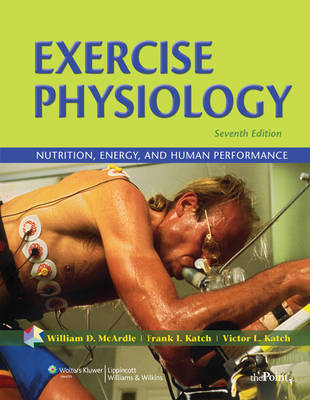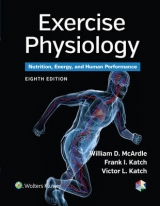
Exercise Physiology
Lippincott Williams and Wilkins (Verlag)
978-0-7817-9781-8 (ISBN)
- Titel erscheint in neuer Auflage
- Artikel merken
Since publication of its First Edition in 1981, Exercise Physiology has helped more than 350,000 students build a solid foundation of the scientific principles underlying modern exercise physiology. This Seventh Edition has been thoroughly updated with all the most recent findings, guiding you to the latest understanding of nutrition, energy transfer, and exercise training and their relationship to human performance. This Seventh Edition maintains its popular seven-section structure. It begins with an exploration of the origins of exercise physiology and concludes with an examination of the most recent efforts to apply principles of molecular biology. The book provides excellent coverage of exercise physiology, uniting the topics of energy expenditure and capacity, molecular biology, physical conditioning, sports nutrition, body composition, weight control, and more. Every chapter has been fully revised and updated to reflect the latest information in the field. The updated full-color art program adds visual appeal and improves understanding of key topics.
A companion website includes over 30 animations of key exercise physiology concepts; the full text online; a quiz bank; references; appendices; information about microscope technologies; a timeline of notable events in genetics; a list of Nobel Prizes in research related to cell and molecular biology; the scientific contributions of thirteen outstanding female scientists; an image bank; a Brownstone test generator; PowerPoint[registered] lecture outlines; and image-only PowerPoint[registered] slides.
Introduction: A View of the Past: Exercise Physiology-Roots and Historical Perspectives Interview with Dr. Charles Tipton PART ONE: EXERCISE PHYSIOLOGY Section 1: Nutrition: The Base for Human Performance Interview with Dr. David L. Costill Chapter 1: Carbohydrates, Lipids, and Proteins Chapter 2: Vitamins, Minerals, and Water Chapter 3: Optimal Nutrition for Exercise Section 2: Energy for Physical Activity Interview with Dr. John O. Holloszy Chapter 4: Energy Value of Food Chapter 5: Introduction to Energy Transfer Chapter 6: Energy Transfer in the Body Chapter 7: Energy Transfer in Exercise Chapter 8: Measurement of Human Energy Expenditure Chapter 9: Human Energy Expenditure During Rest and Physical Activity Chapter 10: Energy Expenditure During Walking, Jogging, Running, and Swimming Chapter 11: Individual Differences and Measurement of Energy Capacities Section 3: Aerobic Systems of Energy Delivery and Utilization Interview with Dr. Loring B. Rowell Chapter 12: Pulmonary Structure and Function Chapter 13: Gas Exchange and Transport Chapter 14: Dynamics of Pulmonary Ventilation Chapter 15: The Cardiovascular System Chapter 16: Cardiovascular Regulation and Integration Chapter 17: Functional Capacity of the Cardiovascular System Chapter 18: Skeletal Muscle: Structure and Function Chapter 19: Neural Control of Human Movement Chapter 20: The Endocrine System: Organization and Acute and Chronic Responses to Exercise PART TWO: APPLIED EXERCISE PHYSIOLOGY Section 4: Enhancement of Energy Capacity Interview with Dr. Bengt Saltin Chapter 21: Training for Anaerobic and Aerobic Power Chapter 22: Muscular Strength: Training Muscles to Become Stronger Chapter 23: Special Aids to Exercise Training and Performance Section 5: Exercise Performance and Environmental Stress Interview with Dr. Barbara Drinkwater Chapter 24: Exercise at Medium and High Altitude Chapter 25: Exercise and Thermal Stress Chapter 26: Sport Diving Chapter 27: Microgravity: The Last Frontier Section 6: Body Composition, Energy Balance, and Weight Control Interview with Dr. Claude Bouchard Chapter 28: Body Composition Assessment Chapter 29: Physique, Performance, and Physical Activity Chapter 30: Overweight, Obesity, and Weight Control Section 7: Exercise, Successful Aging, and Disease Prevention Interview with Dr. Steven N. Blair Chapter 31: Physical Activity, Health, and Aging Chapter 32: Clinical Exercise Physiology for Cancer, Cardiovascular, and Pulmonary Rehabilitation On the Horizon Interview with Dr. Frank Booth Molecular Biology: A New Vista for Exercise Physiology Index
| Erscheint lt. Verlag | 25.11.2009 |
|---|---|
| Zusatzinfo | col. Illustrations |
| Verlagsort | Philadelphia |
| Sprache | englisch |
| Maße | 213 x 277 mm |
| Gewicht | 2860 g |
| Themenwelt | Studium ► 1. Studienabschnitt (Vorklinik) ► Physiologie |
| ISBN-10 | 0-7817-9781-0 / 0781797810 |
| ISBN-13 | 978-0-7817-9781-8 / 9780781797818 |
| Zustand | Neuware |
| Informationen gemäß Produktsicherheitsverordnung (GPSR) | |
| Haben Sie eine Frage zum Produkt? |
aus dem Bereich



